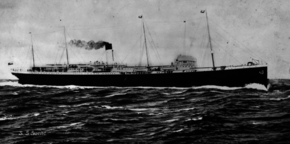
S6133
WICKS, Frank Arnold
| Service Numbers: | 12784, 12704 |
|---|---|
| Enlisted: | Not yet discovered |
| Last Rank: | Private |
| Last Unit: | 11th Field Ambulance |
| Born: | Adelaide, South Australia, date not yet discovered |
| Home Town: | Adelaide, South Australia |
| Schooling: | Not yet discovered |
| Occupation: | nurseryman |
| Died: | Circumstances of death not yet discovered |
| Cemetery: |
Centennial Park Cemetery, South Australia |
| Memorials: | Payneham District Council Roll of Honor, Payneham Road Uniting (Methodist) Church Honor Roll, St Peters Heroes of the Great War Honour Roll, St. Peters East Adelaide Public School Roll of Honour |
World War 1 Service
| 31 May 1916: | Involvement Private, 12784, 11th Field Ambulance, --- :embarkation_roll: roll_number: '23' embarkation_place: Adelaide embarkation_ship: HMAT Suevic embarkation_ship_number: A29 public_note: '' | |
|---|---|---|
| 31 May 1916: | Embarked Private, 12784, 11th Field Ambulance, HMAT Suevic, Adelaide | |
| 11 Nov 1918: | Involvement Private, 12704, 11th Field Ambulance |
Help us honour Frank Arnold Wicks's service by contributing information, stories, and images so that they can be preserved for future generations.
Add my storyBiography
Frank Arnold Wicks was born in South Australia and grew up in the suburb of Riverside, Payneham. He was a nurseryman. He enjoyed growing and looking after different types of plants. Frank was a Methodist and attended church regularly.
At the time Frank was at an average height. He was around 5 feet 6 inches, which was not very tall for a soldier fighting in war. He weighed just over 63 kilograms (140lbs) and had dark hair and brown eyes. His complexion was healthy and he showed good signs of being fit.Frank joined the army on the 21st of December 1915. As son of Mrs Marion Trevener Wicks, (the next of kin) he was only 21 years of age and still single when he embarked on the 31st of May 1916 in Adelaide. After lots of basic but hard training, he finally got on the HMAT Suevic A29 ship and was on his way to fight. His service number was 12784. He was ranked as a private in the roll title of an 11th field Ambulance. This title consisted in the 41st, 42nd 43rd and 44th battalions.
The 11th field ambulance was a mobile frontline medical unit. They would look after the injured, sick or wounded soldiers that were not well enough to fight. Field ambulances were however under demand of the division head quarters rather than the support Brigade. They supported the 11th brigade of the 3rd division. The 11th field ambulance was formed at Mitcham, South Australia on the 1st of March 1916. This group however was split into 4 battalions.-( RSL war memorial https://rslvirtualwarmemorial.org.au )
The 41st battalion was raised at Bell’s paddock camp located in Brisbane in January 1916. After training in Britain and Australia, the Australian troops were sent to France in November later that year. These soldiers spent most of the winter including Christmas Eve, switching from training and working behind the scenes to the front line. Due to his vote as an 11th he was busy bringing back and forward, injured and wounded soldiers. This in some circumstances was more dangerous than fighting as they were often exposed to enemy fire without protection. (https://www.awm.gov.au/unit/U51481/ - Australian war memorial)
On the 4th of August 1917, Frank was admitted to hospital with Neuralgia. He spent a significant amount of time in and out of hospital due to this condition. Neuralgia is a very painful condition that affects the nervous system in the face and head due to stress. In World War 1, this was common because soldiers were put under duress and major stress when fighting. Causes of stress may have come from carrying and help out the soldiers that were dying. Too see this would have been traumatic. When he finally became well, he permanently re-joined the unit on the 1st of September 1917.
After his long journey of fighting in the war, Frank returned on the 12th of June 1919. His records show that he received a British War Medal for his service in World War 1. He also received a Star Medal and a Victory Medal for the time he spent fighting for his country.
Frank died back in Adelaide from natural causes. He was buried in the Centennial Park Cemetery, South Australia.
In conclusion Frank Arnold Wicks was only 21 years old when he joined the Australian Army. He was a member of the field ambulance team and supported his battalion during the troubles and difficulties of war. Although he suffered significant health issues during his enlistment he was able to overcome these and return to Australia in 1919. He showed great bravery and skill throughout his service.
Biography
11th field ambulance 2008, /, accessed 5 April 2016, <https://rslvirtualwarmemorial.org.au>. - RSL war memorial https://rslvirtualwarmemorial.org.au
Frank Arnold wicks 2004, UNSW canberra, accessed 5 April 2016,
.https://www.aif.adfa.edu.au/showPerson?pid=322881 - AIF website
http://recordsearch.naa.gov.au/SearchNRetrieve/Interface/DetailsReports/ItemDetail.aspx?Barcode=8389009&isAv=N -digital copy of service records
https://www.awm.gov.au/images/collection/items/ACCNUM_LARGE/RCDIG1067701/RCDIG1067701--23-.JPG - nominal roll
http://recordsearch.naa.gov.au/SearchNRetrieve/Interface/DetailsReports/ItemDetail.aspx?Barcode=8389009&isAv= - record search
https://www.awm.gov.au/search/all/- Australian war memorial
https://www.awm.gov.au/unit/U51481/ - Australian war memorial














